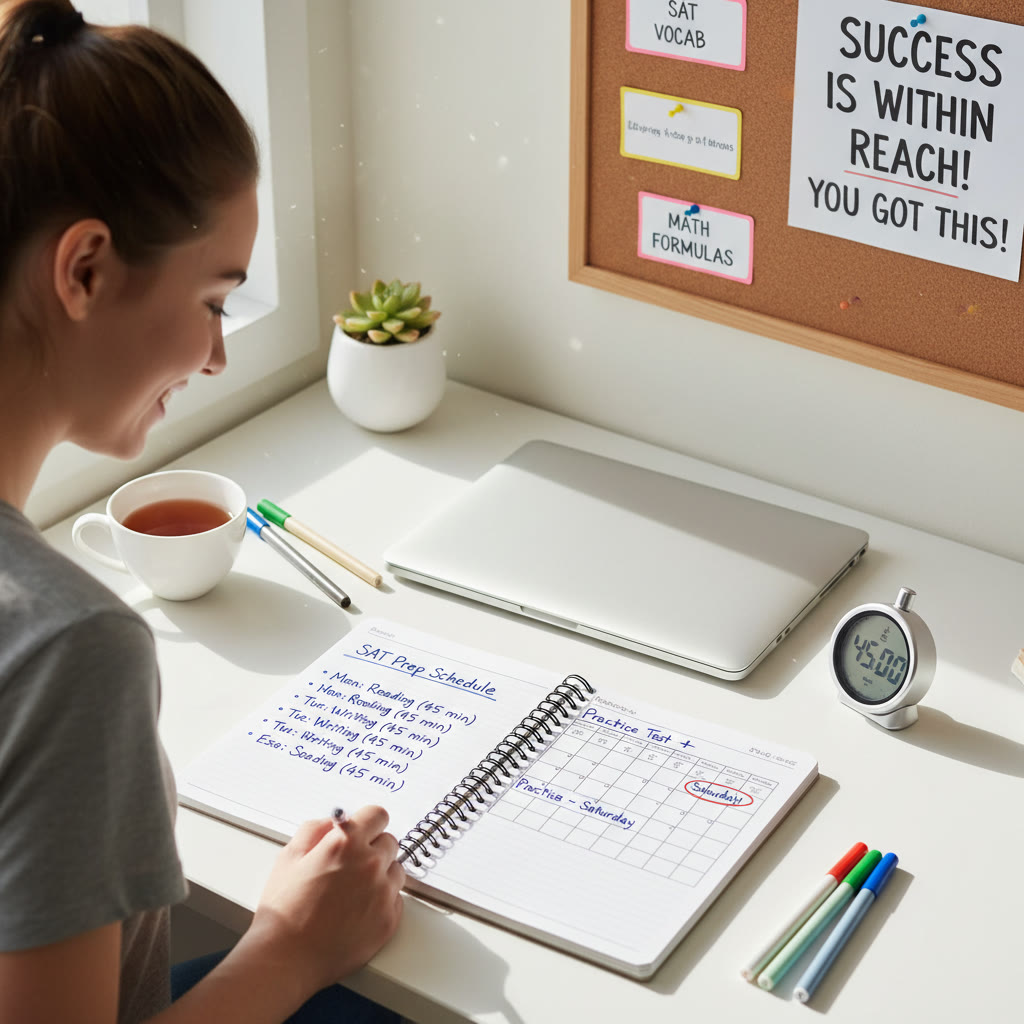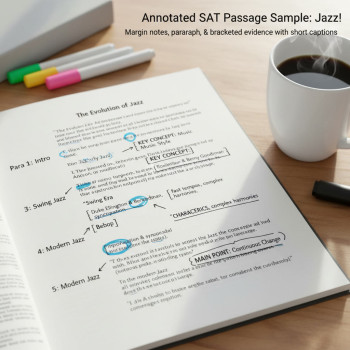The Student Struggle With Overstudying for the SAT
It’s late. The clock reads 1:17 a.m., your desk is a small island of highlighters and half-empty coffee cups, and you’re convinced the next hour will be the one that finally makes the geometry formulas stick. If this scene feels familiar, you’re not alone. For many students, studying for the SAT becomes a Sisyphean cycle: more hours, more problems, more stress — and sometimes, surprisingly, worse results.
Overstudying is different from working hard. It’s the point where hours lose their value and mental fatigue steals efficiency, clarity, and confidence. In this post I want to unpack why more study time can backfire, how the brain actually learns, and, most importantly, how to trade frantic hours for focused, high-impact study that improves scores and preserves sanity. I’ll give practical tactics, a sample weekly plan, and real-world context — including how Sparkl’s personalized tutoring and tailored study plans can fit into a smarter approach.
Why students fall into the overstudying trap
There are a few familiar forces pushing students toward marathon study sessions:
- Fear of failure: The SAT feels decisive. When stakes feel high, it’s tempting to assume the fix is simply “more.”
- Perfectionism: The belief that every practice test must be perfect leads to endless review instead of targeted correction.
- Poor planning: Without a structured plan or feedback on weak areas, students repeat the same ineffective routines.
- Social pressure: Seeing classmates study long hours can create a false benchmark: if others grind, you should too.
- Misinformation: Myths like “more flashcards = more mastery” ignore how memory and attention actually work.
That anxious equation: more hours ≠ better scores
It’s tempting to quantify studying in hours and assume linear return: study 50% more, get 50% better. But learning isn’t linear. Cognitive resources like attention and working memory deplete during long sessions. After a certain point you’re not encoding new information — you’re cycling through the same tired neurons. Worse: you’re reinforcing mistakes or surface-level familiarity rather than deep understanding.
The science behind learning and why overstudying fails
Understanding why overstudying fails starts with two reliable findings from cognitive science:
- Spacing works: Repeated exposure spaced over time produces stronger, longer-lasting memory than massed practice (cramming).
- Active recall beats passive review: Testing yourself and retrieving information strengthens memory far more than re-reading notes.
When students study for hours in a row, they often rely on passive review — skimming notes, re-reading passages, flicking through flashcards. This can give the illusion of mastery because the material feels familiar. But familiarity != recall under pressure.
Sleep also matters. Memory consolidation — the process of stabilizing a memory trace after initial acquisition — happens during sleep. Cramming all night before a test sabotages the brain’s ability to consolidate what you tried to learn.
Signs you’re overstudying
Before we jump to solutions, here are signals that you’ve crossed the line from “dedicated” to “diminished returns.” If several of these describe you, it’s time to adjust your approach:
- Longer study hours but flat or falling practice-test scores.
- Difficulty focusing during previously manageable tasks.
- Memory slips — you know you studied something but can’t recall it under timed conditions.
- Increased anxiety at the thought of studying or taking the test.
- Physical signs of burnout: headaches, poor sleep, or irritability.
Quality over quantity: practical strategies to study smarter
The antidote to overstudying is a shift from raw hours to smarter methods that respect your brain’s limits. Here are evidence-backed strategies students can use immediately.
1. Plan backward from the test
Start with the test date and work backward. Identify milestones: baseline diagnostic test, targeted practice (e.g., math fundamentals, grammar rules), full-length practice tests, and rest/mental prep. A timeline reduces panic and prevents last-minute cramming.
2. Use active recall and spaced repetition
Instead of re-reading passages, actively retrieve information. Try practice questions, closed-book recalls, or explaining a concept aloud. Pair retrieval with spaced repetition: revisit topics at increasing intervals (1 day, 3 days, 1 week, 3 weeks).
3. Embrace deliberate practice
It’s not enough to do problems — you must target weak points. After each practice test, categorize mistakes (conceptual, careless, timing). Build short drills to fix specific errors and retest until errors decrease.
4. Time-box study sessions
Short, focused sessions beat marathon blocks. Use 45–60 minute study blocks with a 10–15 minute break, or try the Pomodoro method (25-minute work, 5-minute break). The goal is sustained attention, not endurance.
5. Prioritize sleep, nutrition, and movement
Sleep consolidates learning; aim for consistent 7–9 hours. Fuel your brain with balanced meals and hydrate. Short bouts of exercise boost concentration and mood — 20 minutes of brisk walking can be surprisingly restorative between study blocks.
6. Simulate real conditions
Take full-length, timed practice tests under quiet, test-like conditions. This helps with pacing and builds mental stamina without needing endless nightly sessions. After a practice test, schedule a calm review period — not immediate re-study into exhaustion.
A sample weekly plan: Balanced study vs. Overstudying
Seeing the difference in a concrete plan can be clarifying. Here’s a simplified comparison of a balanced week versus an overstudy week for a student with 14 hours available to study.
| Day | Balanced Plan (sustainable, effective) | Overstudy Plan (common but counterproductive) |
|---|---|---|
| Monday | 1.5 hr focused math (targeted drills), 30 min review of errors | 3 hr math marathon, re-reading notes the whole time |
| Tuesday | 1 hr reading practice (timed passages), 45 min vocabulary recall | 2.5 hr unstructured reading and highlighting |
| Wednesday | 1.5 hr writing/grammar drills, 30 min timed practice questions | 3 hr grammar worksheets with little review |
| Thursday | 1 hr mixed problem set, 30 min flashcard spaced review | 2.5 hr repeated practice without breaks |
| Friday | Full rest or light 30 min review + 30 min exercise | 3 hr late-night cram session |
| Saturday | 3 hr full-length practice test + 1 hr cool-down review (score analysis) | 4+ hr full-length test, then another 3 hr study binge |
| Sunday | 1 hr targeted weak-point drills, plan next week | 2 hr mixed review, burnout begins |
Notice the difference: both weeks tot up to similar raw time, but the balanced plan preserves high-quality focus, recovery, and consolidation. The overstudy plan looks productive on paper but delivers less learning and more fatigue.
Real-world examples and comparisons
Consider two students: Maria and Devon. Both have similar academic backgrounds and the same SAT target. Maria uses a disciplined, targeted approach: weekly diagnostics, spaced review, and short, focused blocks. She also gets one-on-one guidance from a tutor who helps build a tailored plan and identifies problem patterns. Devon studies longer hours, crams most nights, and re-reads passages without timing himself.
After eight weeks, Maria’s practice-test scores steadily rise and feel stable under timed conditions. She’s calm on test day. Devon’s scores bounce — sometimes high after a last-minute cram, often lower under timed pressure — and he’s exhausted and anxious before the real test.
This contrast isn’t moralizing. It’s about the mechanisms of learning: structured, feedback-driven practice builds reliable retrieval; aimless volume builds fragile familiarity.
An anecdote: the 10-point turnaround
One student I know — call him Aaron — hit a wall two months before his test. He was studying nine hours a day but couldn’t improve. His tutor suggested a radical experiment: cut study to three high-quality hours, add targeted drills, schedule two full rests, and prioritize sleep. Aaron also used weekly timed practice tests and had short 1-on-1 check-ins for error analysis. Over six weeks, his score rose by 120 points, and he reported feeling less anxious. That’s the power of strategy over slog.
How tutors and personalized plans help (and when to get help)
A skilled tutor or coach can be the difference between spinning wheels and steady progress. They do more than assign homework — they diagnose patterns, suggest high-yield materials, and provide accountability. Personalized tutoring is especially helpful when you:
- Hit a plateau despite consistent effort.
- Have limited time and need a prioritized plan.
- Struggle with test-day anxiety or pacing.
Sparkl’s personalized tutoring brings several advantages that fit naturally into a smarter study plan: 1-on-1 guidance to isolate weaknesses, tailored study plans that prevent wasted hours, expert tutors who model efficient approaches, and AI-driven insights that track progress and adapt practice. These features help replace guesswork and overstudying with targeted, evidence-based work.
Practical checklist to stop overstudying today
Here’s a short, actionable checklist you can use right now:
- Take a timed diagnostic to find baseline weaknesses.
- Create a 6–8 week backward plan with milestones.
- Limit daily study to focused blocks (2–4 hours max most days).
- Use active recall and spaced repetition — write answers, don’t just read.
- Analyze every practice test: categorize mistakes and drill those specifically.
- Schedule full-length tests under test conditions once per week or biweekly.
- Protect sleep and rest days as part of the plan, not as optional extras.
- Consider one-on-one tutoring to create a personalized, efficient path forward.
Test-day and final-week tips
The final week before the SAT is for consolidation, not frantic accumulation. Here’s how to use it wisely:
- Reduce study volume and increase short reviews of high-yield items.
- Take one last full practice test early in the week, analyze errors, then stop heavy studying three days before the exam.
- Do light, confidence-building activities: timed mini-passage sets, quick math drills, and breathing exercises.
- Plan logistics: sleep schedule, test materials, and travel — reducing uncertainty so your mind can rest.
Common questions students ask
How many hours should I study for the SAT?
Quality matters more than a single number. For many students, 6–12 focused hours per week over 6–8 weeks, combined with weekly full-length practice tests and targeted remediation, is effective. Some students need more, some less — but long nightly marathons are rarely efficient.
Is cramming ever useful?
Cramming can help with very small goals, like memorizing a few vocabulary words or refreshing a formula. For long-term retrieval and test performance under pressure, spaced, active practice is far superior.
What if I feel guilty taking a full rest day?
Rest days are productive. They allow consolidation and reset attention. Think of them as part of your study plan, not as wasted time.
Final thoughts: study with intention, not exhaustion
Preparing for the SAT is a marathon that rewards strategy, not sheer endurance. Overstudying is common because intentions are good: students want to do well. But the smarter route is to combine targeted practice, recovery, and measurement. Replace endless hours with deliberate routines that build reliable recall and timing under pressure.
If you feel stuck, there’s no shame in asking for help. A tutor can shorten the path by diagnosing weak spots, building a tailored plan, and providing encouragement. Sparkl’s personalized tutoring — with 1-on-1 guidance, tailored study plans, expert tutors, and AI-driven insights — is one approach that many students find helpful when they need structure and efficient acceleration.


You’ve got this. The work you put in can be smarter and kinder to your mind. Swap the illusion of endless hours for systems that make each minute count. Your score — and your mental health — will thank you.











No Comments
Leave a comment Cancel